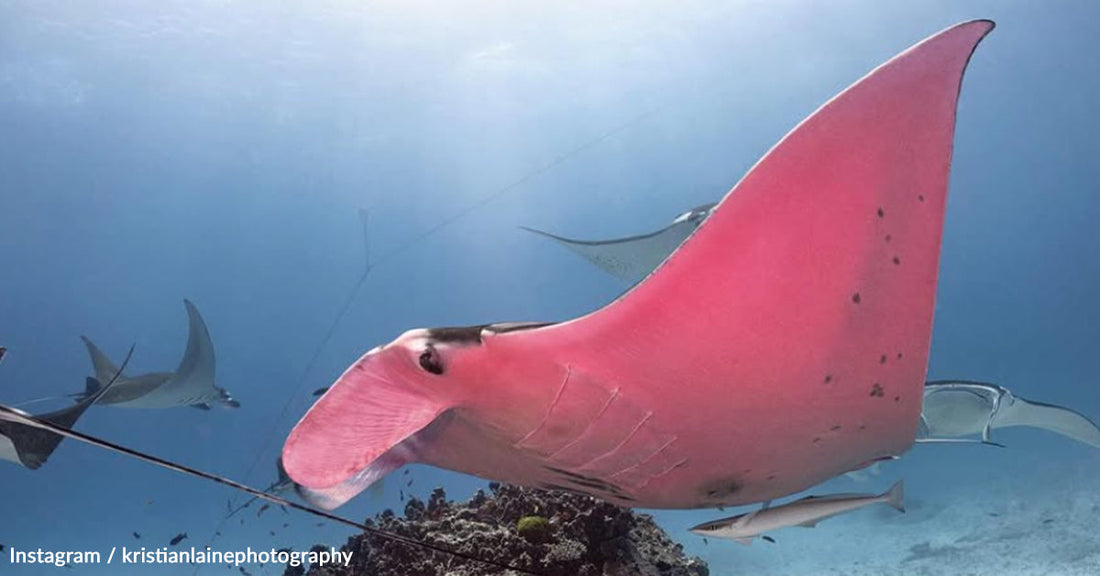The Mystery Behind the World's Only Known Pink Manta Ray
Matthew Russell
The world's oceans are full of wonders, many of which remain hidden from our view. But occasionally, nature surprises us with an extraordinary sight, one that defies the ordinary and leaves scientists and observers alike in awe. Meet Inspector Clouseau, a rare pink manta ray spotted off the coast of Lady Elliot Island, Australia.
This 11-foot male ray is the only known manta of its kind, with a vibrant pink hue that has intrigued the scientific community since its discovery in 2015.

Inspector Clouseau is the only known pink manta ray in the world.
How Inspector Clouseau’s Pink Hue Stands Out
The first sighting of Inspector Clouseau in 2015 stunned diver Ryan Jeffery, who documented the peculiar fish. At first, Jeffery thought his camera equipment was malfunctioning, but upon further inspection, he realized he had captured a rare occurrence: a pink manta ray. The animal’s stunning coloration is a stark contrast to the usual black-and-white camouflage of typical manta rays, which allows them to blend into the ocean's depths.
This rare sight has captivated researchers, especially those working with Project Manta, a research group dedicated to studying these enigmatic creatures. They initially speculated that the pink coloration could be the result of an infection or an unusual diet, similar to how flamingos develop their pink feathers from eating crustaceans. However, after a biopsy taken in 2016, it became clear that neither infection nor diet was responsible for the ray's striking color. Instead, scientists proposed that the hue is likely due to a genetic mutation affecting melanin, the pigment responsible for color in animals.

The ray was first spotted near Lady Elliot Island in 2015.
A Genetic Mutation Behind the Color
The theory behind Clouseau’s coloration centers around a rare genetic condition called erythrism. This mutation causes an animal’s pigment to produce a reddish or pinkish hue, a phenomenon also seen in other animals like strawberry-blonde leopards and fuchsia grasshoppers. Dr. Kathy Townsend from Project Manta told Smithsonian Magazine that this mutation is not entirely unique in the animal world, but the fact that it has appeared in a manta ray is groundbreaking.
The rarity of this color has sparked discussions among marine scientists about the broader implications of such mutations in the animal kingdom. Dr. Solomon David, an aquatic ecologist, noted that while such genetic mutations aren't uncommon in fish, it remains an exciting discovery in the world of manta rays.
The Enigmatic Mating Dance of Inspector Clouseau
Though his unique appearance might suggest that Clouseau leads an isolated life, he often mingles with other manta rays, particularly during the breeding season. In a particularly dramatic display of courtship, Clouseau was spotted in the company of seven other male manta rays, all competing for the attention of a nearby female. This behavior is typical in manta rays, where males engage in an elaborate mating ritual triggered by the release of pheromones from the female.
Despite his unusual pink color, Clouseau's participation in these rituals doesn't seem to hinder his social interactions. In fact, his striking color might even attract more attention, though whether it aids or impedes his mating prospects remains an open question. As National Geographic reported, this fascinating social behavior among manta rays is still being studied, with Clouseau often seen among other males in pursuit of the same goal.
Where to See Inspector Clouseau
For those hoping to catch a glimpse of this magnificent creature, Lady Elliot Island, located in the southern part of the Great Barrier Reef, is the place to visit. The island is renowned for its rich marine biodiversity, and despite the rarity of Clouseau's sightings, divers have been fortunate enough to photograph the elusive ray over the years.
As scientists continue their studies of Clouseau, they remain hopeful that future sightings will shed more light on the genetic mutation behind his pink hue. In the meantime, his story serves as a reminder of the surprises nature still has in store for us. The Manta Ray Advocates community continues to document this rare and extraordinary creature, furthering the public’s knowledge of these majestic ocean giants.
Potential for More Pink Manta Rays?
One of the most exciting possibilities surrounding Inspector Clouseau is the potential for other pink manta rays to emerge. If his unique coloration is indeed the result of a genetic mutation, there could be a chance for the trait to be passed on to future generations. Researchers are closely monitoring the area, hoping to catch sight of any offspring that might share Clouseau's rare genetic gift.
But whether or not Clouseau's pink hue will become more common remains to be seen. For now, the world's only known pink manta ray continues to capture the imagination of scientists and nature lovers around the globe, reminding us of the astonishing variety of life that exists beneath the surface of our oceans.

